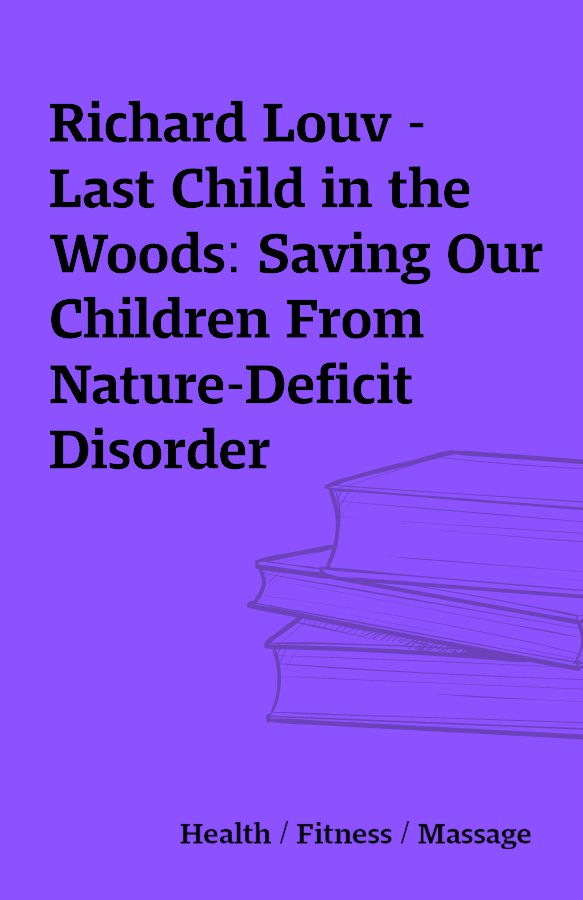Richard Louv – Last Child in the Woods: Saving Our Children From Nature-Deficit Disorder
Last Child in the Woods – Saving Our Children From Nature-Deficit Disorder
[2 ebooks – 1 epub, 1 pdf]
Description
“The children and nature movement is fueled by this fundamental idea: the child in nature is an endangered species, and the health of children and the health of the Earth are inseparable.” —Richard Louv, from the new editionIn his landmark work Last Child in the Woods, Richard Louv brought together cutting-edge studies that pointed to direct exposure to nature as essential for a child’s healthy physical and emotional development. Now this new edition updates the growing body of evidence linking the lack of nature in children’s lives and the rise in obesity, attention disorders, and depression. Louv’s message has galvanized an international back-to-nature campaign to “Leave No Child Inside.” His book will change the way you think about our future and the future of our children.“[The] national movement to ‘leave no child inside’ . . . has been the focus of Capitol Hill hearings, state legislative action, grass-roots projects, a U.S. Forest Service initiative to get more children into the woods and a national effort to promote a ‘green hour’ in each day. . . . The increased activism has been partly inspired by a best-selling book, Last Child in the Woods, and its author, Richard Louv.” —The Washington Post“Last Child in the Woods, which describes a generation so plugged into electronic diversions that it has lost its connection to the natural world, is helping drive a movement quickly flourishing across the nation.” —The Nation’s Health “This book is an absolute must-read for parents.” —The Boston Globe Now includesA Field Guide with 100 Practical Actions We Can Take Discussion Points for Book Groups, Classrooms, and Communities Additional Notes by the Author New and Updated Research from the U.S. and AbroadFrom the Introduction:Quote:ONE EVENING WHEN my boys were younger, Matthew, then ten, looked at me from across a restaurant table and said quite seriously, “Dad, how come it was more fun when you were a kid?”I asked what he meant.“Well, you’re always talking about your woods and tree houses, and how you used to ride that horse down near the swamp.”At first, I thought he was irritated with me. I had, in fact, been telling him what it was like to use string and pieces of liver to catch crawdads in a creek, something I’d be hard-pressed to find a child doing these days. Like many parents, I do tend to romanticize my own childhood—and, I fear, too readily discount my children’s experiences of play and adventure. But my son was serious; he felt he had missed out on something important.He was right. Americans around my age, baby boomers or older, enjoyed a kind of free, natural play that seems, in the era of kid pagers, instant messaging, and Nintendo, like a quaintartifact.Within the space of a few decades, the way children understand and experience nature has changed radically. The polarity of the relationship has reversed. Today, kids are aware of the global threats to the environment—but their physical contact, their intimacy with nature, is fading. That’s exactly the opposite of how it was when I was a child.As a boy, I was unaware that my woods were ecologically connected with any other forests. Nobody in the 1950s talked about acid rain or holes in the ozone layer or global warming. But I knew my woods and my fields; I knew every bend in the creek and dip in the beaten dirt paths. I wandered those woods even in my dreams. A kid today can likely tell you about the Amazon rain forest—but not about the last time he or she explored the woods in solitude, or lay in a field listening to the wind and watching the clouds move.This book explores the increasing divide between the young and the natural world, and the environmental, social, psychological, and spiritual implications of that change. It also describes the accumulating research that reveals the necessity of contact with nature for healthy child—and adult—development.ContentsCover PagePraise for Last Child in the WoodsAlso by Richard LouvTitle PageCopyright PageDedicationContentsAcknowledgmentsINTRODUCTIONPART I : THE NEW RELATIONSHIP BETWEEN CHILDREN AND NATURE1. Gifts of Nature2. The Third Frontier3. The Criminalization of Natural PlayPART II: WHY THE YOUNG (AND THE REST OF US) NEED NATURE4. Climbing the Tree of Health5. A Life of the Senses: Nature vs. the Know-It-All State of Mind6. The “Eighth Intelligence”7. The Genius of Childhood: How Nature Nurtures Creativity8. Nature-Deficit Disorder and the Restorative EnvironmentPART III: THE BEST OF INTENTIONS: WHY JOHNNIE AND JEANNIE DON’T PLAY OUTSIDEANYMORE9. Time and Fear10. The Bogeyman Syndrome Redux11. Don’t Know Much About Natural History: Education as a Barrier to Nature12. Where Will Future Stewards of Nature Come From?PART IV: THE NATURE-CHILD REUNION13. Bringing Nature Home14. Scared Smart: Facing the Bogeyman15. Telling Turtle Tales: Using Nature as a Moral TeacherPART V: THE JUNGLE BLACKBOARD16. Natural School Reform17. Camp RevivalPART VI: WONDER LAND: OPENING THE FOURTH FRONTIER18. The Education of Judge Thatcher: Decriminalizing Natural Play19. Cities Gone Wild20. Where the Wild Things Will Be: A New Back-to-the-Land MovementPART VII: TO BE AMAZED21. The Spiritual Necessity of Nature for the Young22. Fire and Fermentation: Building a Movement23. While It LastsNOTESSUGGESTED READINGINDEXA FIELD GUIDE TO LAST CHILD IN THE WOODSPaperback: 416 pagesPublisher: Algonquin Books; Updated and Expanded edition (April 22 2008)Language: EnglishISBN-10: 156512605XISBN-13: 978-1565126053ASIN: B0015DRPAYSource: http://www.amazon.ca/Last-Child-Woods-Children-Nature-Defici…
You must be logged in to post a review.






Reviews
There are no reviews yet.